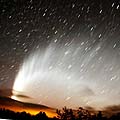
|
Excellent great comet, few times in a lifetime, for southern people. It reached to -5.5 mag on Jan. 14 and 15, brighter than Venus, and visible even in daytime. Then it appeared in the evening sky in the Southern Hemisphere and many people enjoyed a fantastic view of a beautiful great comet, a enormous curving tail with so many striae over 50 degrees. Now it is observable both in the evening and morning. It has already faded down to 6.5 mag (Mar. 11, Walter Ruben Robledo). In the Southern Hemisphere, It keeps observable almost all night until the comet has gone. It will never be observable again in the Northern Hemisphere.
Date(TT) R.A. (2000) Decl. Delta r Elong. m1 Best Time(A, h)
Mar. 10 22 40.94 -64 42.9 1.664 1.463 60 6.6 4:28 (333, 25)
Mar. 17 22 57.81 -66 30.4 1.724 1.592 65 7.0 4:35 (334, 27)
|
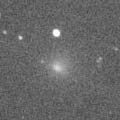
|
It will reach to 6 mag at the perihelion passage in mid April. It has already started brightening very rapidly. Now it is 11.0 mag (Mar. 11, Reinder J. Bouma), already visible visually. It is observale while brightening gradually in the evening sky in the Northern Hemisphere. However, it will locate very low after this. It will be 11.5 mag in mid March, when the altitude becomes lower than 10 degree. After conjunction with the sun, it appears in the morning sky at 12 mag in June. But it locates only 20 degree high at most, and it will be fading rapidly. In the Southern Hemisphere, it appears in the morning sky at 8 mag in May, then it will be bright and observable for a while.
Date(TT) R.A. (2000) Decl. Delta r Elong. m1 Best Time(A, h)
Mar. 10 0 52.29 12 24.4 1.714 0.966 28 11.4 19:51 ( 99, -9)
Mar. 17 1 10.74 14 0.3 1.613 0.846 26 10.8 19:41 (101,-10)
|
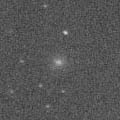
|
First return of a new bright periodic comet observed at 9 mag in 2001. It brightened rapidly also in this return. It was 16.1 mag on Jan. 11 (Filip Fratev), but it brightened up to 11.1 mag on Mar. 11 (Reinder J. Bouma). Unexpectedly, it became as bright as at the discovery, and visible visually. However, the condition of this apparition is bad. It keeps locating very low in the evening until early May. It kept brightening even after passing the perihelion, but it will be fading after this.
Date(TT) R.A. (2000) Decl. Delta r Elong. m1 Best Time(A, h)
Mar. 10 1 21.26 5 29.7 1.643 0.958 32 11.6 19:51 ( 98, 1)
Mar. 17 1 54.60 7 20.5 1.646 0.985 33 11.7 19:41 (102, 3)
|

|
Not yet observed in this return. But it must be brihtening very rapidly towards the perihelion passage on Apr. 4. However, it is not observable until April. It will appear in the morning sky at 8 mag in mid April in the Northern Hemisphere, or at 10 mag in late April in the Southern Hemisphere. Then the condition will get better rapidly. However, the comet will fade out rapidly. It will be fainter than 14 mag in mid May, too faint to see visually.
Date(TT) R.A. (2000) Decl. Delta r Elong. m1 Best Time(A, h)
Mar. 10 23 8.02 -29 30.7 1.596 0.817 25 13.2 4:28 (307, 0)
Mar. 17 23 41.98 -24 25.6 1.439 0.649 22 11.6 4:35 (303, -3)
|
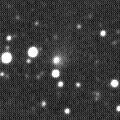
|
Now it is 12.6 mag (Mar. 9, Edwin van Dijk). It has been 12 mag for half a year since last June. But it will start fading after this. It will be too faint to see visually in April. However, the fading is slow. The comet will be fainter than 18 mag in 2008. In the Northern Hemisphere, it keeps observable until that time. In the Northern Hemisphere, it keeps observable all night for a while after this.
Date(TT) R.A. (2000) Decl. Delta r Elong. m1 Best Time(A, h)
Mar. 10 21 3.28 66 6.5 2.452 2.389 74 13.2 4:28 (207,-28)
Mar. 17 21 47.13 68 27.4 2.533 2.435 72 13.4 4:35 (205,-30)
|
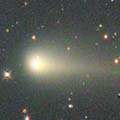
|
It reached up to 9.3 mag between October and November (Oct. 27, Juan Jose Gonzalez). It had been observable in excellent condition. But it is fading now. It has already faded down to 13.1 mag (Mar. 8, Reinder J. Bouma). However, it keeps observable after this until May when it fades down to 16 mag.
Date(TT) R.A. (2000) Decl. Delta r Elong. m1 Best Time(A, h)
Mar. 10 4 47.52 12 40.2 1.863 2.005 83 13.6 19:51 (140, 33)
Mar. 17 5 1.71 13 22.0 1.966 2.041 79 13.9 19:41 (140, 32)
|

|
In this season, it has been bright as 12-13 mag and visible visually since it appeared in the morning sky in early July. It is visible visually as 12.6 mag still now (Mar. 9, Reinder J. Bouma). It will be getting lower in the evening sky after this. It will be too low to see in April.
Date(TT) R.A. (2000) Decl. Delta r Elong. m1 Best Time(A, h)
Mar. 10 3 55.36 28 27.6 6.088 5.890 73 13.7 19:51 (139, 13)
Mar. 17 3 59.17 28 27.5 6.196 5.892 67 13.7 19:41 (137, 11)
|
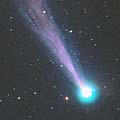
|
It suddenly brightened in outburst on Oct. 24, and reached up to 4.2 mag on Oct. 25 (Maik Meyer). But it had faded down to 10.5 mag on Jan. 11 (Carlos Labordena). Now it is not observable. It will appear in the morning sky again at 15-16 mag in May. Then it keeps observable until it becomes fainter than 18 mag in autumn.
Date(TT) R.A. (2000) Decl. Delta r Elong. m1 Best Time(A, h)
Mar. 10 22 24.07 -8 8.4 3.657 2.705 14 14.2 4:28 (283, -5)
Mar. 17 22 30.29 -8 21.6 3.708 2.792 19 14.4 4:35 (280, 1)
|
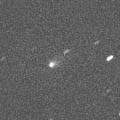
|
Now it is 13.1 mag (Feb. 14, Masayuki Suzuki). It has been 13 mag for a long time since last autumn. However, it will be fading gradually after this. It is observable in good condition in the Southern Hemisphere, although it is already not observable in the Northern Hemisphere.
Date(TT) R.A. (2000) Decl. Delta r Elong. m1 Best Time(A, h)
Mar. 10 16 2.16 -69 9.2 2.005 2.278 92 14.2 4:28 (356, 56)
Mar. 17 16 15.93 -70 30.7 1.998 2.319 95 14.3 4:35 (359, 54)
|
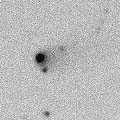
|
It has been visible at 13.5 mag for a long time since 2005 autumn until 2006 spring. Now it is fainter than last year by 1 mag, however, it is still visible visually at 14.2 mag (Dec. 22, Seiichi Yoshida). It keeps observable in excellent condition until April.
Date(TT) R.A. (2000) Decl. Delta r Elong. m1 Best Time(A, h)
Mar. 10 13 6.11 23 57.4 4.896 5.759 147 14.5 1:58 (180, 31)
Mar. 17 13 3.18 24 5.6 4.894 5.782 150 14.5 1:28 (180, 31)
|
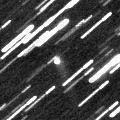
|
Now it is 14.4 mag (Feb. 12, Juan Jose Gonzalez). Almost asteroidal. It did not brighten at all since early September. Although the slight cometary activity was detected in late July, it became completely stellar soon. Its tail became visible again in late October, however, it turned to be stellar again soon. Finally it has passed the perihelion, keeping almost asteroidal. It kept observable at 14 mag in good condition in the Northern Hemisphere for a long time. However, it will be fading after this. It will start getting lower in April, and will be too low in the evening sky at 17 mag in June.
Date(TT) R.A. (2000) Decl. Delta r Elong. m1 Best Time(A, h)
Mar. 10 5 34.45 28 9.7 1.084 1.538 95 14.6 19:51 (159, 24)
Mar. 17 5 57.94 25 2.1 1.186 1.595 93 14.8 19:41 (160, 27)
|
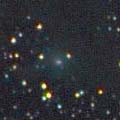
|
Michael Jager and Gerald Rhemann reported it was bright as 14.5 mag on Mar. 11. It seems to be visible visually at 14 mag. It keeps observable in the evening sky until May. It is not observable around the perihelion passage in conjunction with the sun. Then it moves to the southern sky, and it will be unobservable in the Northern Hemisphere.
Date(TT) R.A. (2000) Decl. Delta r Elong. m1 Best Time(A, h)
Mar. 10 3 38.68 44 7.8 2.503 2.450 75 15.4 19:51 (146, -2)
Mar. 17 3 52.92 43 15.2 2.523 2.395 71 15.3 19:41 (145, -1)
|
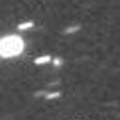
|
Although it had been unobservable since last autumn, now it is appearing again in the morning sky. It will be observable at 14.5 mag from spring to summer both in 2007 and 2008. The condition is good, and it may be visible visually.
Date(TT) R.A. (2000) Decl. Delta r Elong. m1 Best Time(A, h)
Mar. 10 19 1.53 -13 0.8 6.396 6.030 64 15.4 4:28 (258, 39)
Mar. 17 19 1.34 -12 26.8 6.261 6.011 71 15.4 4:35 (250, 45)
|

|
Now it is 15.9 mag (Feb. 15, Mitsunori Tsumura). It will reach to 11 mag in 2008 spring. It keeps moving in the southern sky until that, so it keeps locating very low in the Northern Hemisphere. It keeps observable in good condition in the Southern Hemisphere. In the Northern Hemisphere, it is observable at 16 mag in the evening low sky until March, then it will be unobservable. It will be observable again in a short time in the very low sky at dawn in November at 13 mag. After 2008 March, it will be visible visually at 11 mag in the morning low sky.
Date(TT) R.A. (2000) Decl. Delta r Elong. m1 Best Time(A, h)
Mar. 10 4 53.18 -33 38.2 5.413 5.368 82 15.8 19:51 ( 84, 63)
Mar. 17 4 55.78 -32 48.8 5.420 5.317 78 15.7 19:41 ( 84, 60)
|

|
Now it is 15.3 mag (Jan. 7, Ken-ichi Kadota). It is observable at 15.5-16 mag until spring. But, in the Northern Hemisphere, it locates somewhat low at 20-30 degree high.
Date(TT) R.A. (2000) Decl. Delta r Elong. m1 Best Time(A, h)
Mar. 10 4 45.37 -26 15.6 3.926 3.887 80 15.9 19:51 ( 97, 59)
Mar. 17 4 41.27 -25 1.7 4.026 3.888 74 15.9 19:41 ( 95, 55)
|

|
Now it brightened up to 16.0 mag (Feb. 21, Ken-ichi Kadota). It keeps 15.5-16 mag for one year and a half after this until 2008 summer. However, because the comet moves southwards, it is only observable until 2007 June in the Northern Hemisphere.
Date(TT) R.A. (2000) Decl. Delta r Elong. m1 Best Time(A, h)
Mar. 10 10 39.57 2 17.2 2.779 3.760 169 16.2 23:27 (180, 53)
Mar. 17 10 33.97 2 1.2 2.753 3.713 162 16.1 22:54 (180, 53)
|
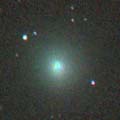
|
When it approached to the earth between from November to early December, it reached up to 8.5 mag as a very large diffuse object with a diameter larger than 10 arcmin (Nov. 23, Peter Bus). However, now it is fading rapidly. It has already faded down to 14.7 mag (Feb. 11, Mitsunori Tsumura). It will set down in the evening sky at 17 mag soon.
Date(TT) R.A. (2000) Decl. Delta r Elong. m1 Best Time(A, h)
Mar. 10 1 22.06 34 38.3 2.954 2.414 48 16.7 19:51 (122,-16)
Mar. 17 1 24.68 34 49.6 3.112 2.483 43 17.2 19:41 (120,-18)
|
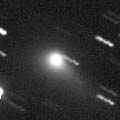
|
It has already faded down to 16.3 mag (Jan. 30, Ken-ichi Kadota). It keeps a good contition until spring, while the comet will be fading gradually.
Date(TT) R.A. (2000) Decl. Delta r Elong. m1 Best Time(A, h)
Mar. 10 9 11.89 26 37.2 3.887 4.712 142 17.0 22:00 (180, 28)
Mar. 17 9 8.79 26 27.2 4.021 4.777 135 17.2 21:30 (180, 29)
|

|
Now it is 16.8 mag (Dec. 29, Katsumi Yoshimoto). It is outside of Jupiter's orbit. So it keeps 17 mag for a long time until 2007 summer. It keeps locating high and observable in good condition for a long time after this because it moves in the northern sky.
Date(TT) R.A. (2000) Decl. Delta r Elong. m1 Best Time(A, h)
Mar. 10 14 41.57 40 12.9 6.683 7.261 122 17.1 3:33 (180, 15)
Mar. 17 14 38.02 40 28.2 6.661 7.276 124 17.1 3:02 (180, 15)
|
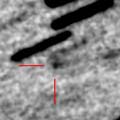
|
It was observed at 19 mag in mid December. It brightened up to 18 mag on Feb. 15. It will reach to 17 mag in spring, and will be observable in good condition.
Date(TT) R.A. (2000) Decl. Delta r Elong. m1 Best Time(A, h)
Mar. 10 10 54.55 5 33.8 1.340 2.330 173 17.1 23:42 (180, 49)
Mar. 17 10 49.82 6 13.9 1.337 2.313 165 17.1 23:10 (180, 49)
|
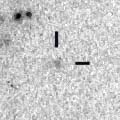
|
It was observed at 17.5 mag in 2006 spring. It will be observable at 17 mag in good condition in 2007 spring.
Date(TT) R.A. (2000) Decl. Delta r Elong. m1 Best Time(A, h)
Mar. 10 14 13.82 -13 18.0 3.987 4.723 133 17.2 3:06 (180, 68)
Mar. 17 14 12.23 -13 13.9 3.913 4.724 140 17.1 2:36 (180, 68)
|
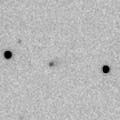
|
It reached to 16 mag in early 2006. Now it is 17.3 mag (Dec. 2, Ken-ichi Kadota). It will be fading very slowly from 17 mag to 18 mag until 2007 summer. In the Northern Hemisphere, it keeps locating high.
Date(TT) R.A. (2000) Decl. Delta r Elong. m1 Best Time(A, h)
Mar. 10 14 20.08 33 48.4 5.127 5.801 128 17.3 3:12 (180, 21)
Mar. 17 14 17.46 34 5.6 5.117 5.828 131 17.3 2:42 (180, 21)
|

|
Very far new comet. It will be observable at 17.5-18 mag more than one year after this.
Date(TT) R.A. (2000) Decl. Delta r Elong. m1 Best Time(A, h)
Mar. 10 9 40.56 -5 31.3 7.916 8.815 153 17.4 22:29 (180, 61)
Mar. 17 9 39.23 -5 1.3 7.954 8.813 147 17.5 22:00 (180, 60)
|

|
It reached to 16.5 mag at best in December and January. But now it is already fading. It will be fainer than 18 mag in April.
Date(TT) R.A. (2000) Decl. Delta r Elong. m1 Best Time(A, h)
Mar. 10 6 25.18 27 15.3 1.864 2.349 106 17.6 19:51 (171, 27)
Mar. 17 6 32.43 26 56.6 1.950 2.356 101 17.7 19:41 (168, 27)
|
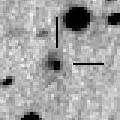
|
It will reach to 11 mag in 2009 summer and autumn. It keeps observable in good condition until 2009 summer in the Northern Hemisphere. But after the maximum brightness, it goes to the southen sky. It will be 14 mag in 2008 summer and visible visually. Then it keeps visible visually for one year.
Date(TT) R.A. (2000) Decl. Delta r Elong. m1 Best Time(A, h)
Mar. 10 5 35.47 48 26.6 7.750 7.915 95 17.6 19:51 (166, 4)
Mar. 17 5 33.72 48 15.2 7.816 7.868 89 17.6 19:41 (163, 3)
|
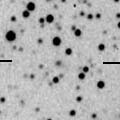
|
It has been observed in good condition at 17 mag. But it will be fading after this, and it becomes fainter than 18 mag in April. It will be observable in good condition at 18 mag again one year later.
Date(TT) R.A. (2000) Decl. Delta r Elong. m1 Best Time(A, h)
Mar. 10 4 28.41 46 24.0 3.787 3.822 84 17.7 19:51 (155, 2)
Mar. 17 4 36.51 46 2.1 3.880 3.824 79 17.8 19:41 (153, 1)
|
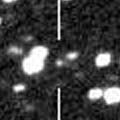
|
It tends to become brightest about 4 months after the perihelion passage. In this apparition, it was 17.6 mag in late July around the perihelion passage (July 23, Filip Fratev), however, it brightened up to 14.1 mag and became visible visually on Dec. 23 (Seiichi Yoshida). But it will start fading after this. Although it keeps a good condition for a long time, it will be fainter than 18 mag in March.
Date(TT) R.A. (2000) Decl. Delta r Elong. m1 Best Time(A, h)
Mar. 10 5 47.45 22 59.7 2.225 2.563 98 17.9 19:51 (160, 29)
Mar. 17 5 55.16 23 16.7 2.349 2.598 92 18.1 19:41 (158, 28)
|

|
It had been lost since its discovery in 1986. But it was rediscovered on Jan. 9 at 16-17 mag. The condition is good in this return, and it was expected to reach to 14 mag from autumn to winter. But actually, it is fainter than originally expected, and it reached to 17 mag at best. Now it is 17.4 mag (Feb. 11, Mitsunori Tsumura). It will be fainter than 18 mag soon.
Date(TT) R.A. (2000) Decl. Delta r Elong. m1 Best Time(A, h)
Mar. 10 1 52.94 12 27.0 2.301 1.694 41 18.6 19:51 (108, 3)
Mar. 17 2 12.27 14 6.0 2.381 1.736 39 18.8 19:41 (109, 3)
|

|
Peculiar asteroid moving along a cometary orbit. It will approach to Sun down to 0.6 A.U. in late April. Then it will pass very near by Earth in May. The condition to observe it is very bad. Nobody can observe it until late May in the Northern Hemisphere. In the Southern Hemisphere, it will be observable in the morning low sky from late April to mid May. It will be 18.5 mag at best if it keeps asteroidal. However, if it shows cometary activity, it may be observed at 12-14 mag in the Southern Hemisphere. Then it may be visible visually at 11 mag in the evening sky in late May also in the Northern Hemisphere.
Date(TT) R.A. (2000) Decl. Delta r Elong. m1 Best Time(A, h)
Mar. 10 0 42.06 -1 54.8 2.048 1.174 20 19.8 19:51 ( 85, -3)
Mar. 17 0 41.70 -2 55.6 2.000 1.064 14 19.4 19:41 ( 82, -6)
|
|
![]()
 C/2006 L2 ( McNaught )
C/2006 L2 ( McNaught ) 4P/Faye
4P/Faye 29P/Schwassmann-Wachmann 1
29P/Schwassmann-Wachmann 1 C/2006 M4 ( SWAN )
C/2006 M4 ( SWAN ) C/2005 YW ( LINEAR )
C/2005 YW ( LINEAR ) C/2003 WT42 ( LINEAR )
C/2003 WT42 ( LINEAR ) P/2006 HR30 ( Siding Spring )
P/2006 HR30 ( Siding Spring ) C/2006 XA1 ( LINEAR )
C/2006 XA1 ( LINEAR ) C/2005 L3 ( McNaught )
C/2005 L3 ( McNaught ) C/2006 Q1 ( McNaught )
C/2006 Q1 ( McNaught ) C/2005 EL173 ( LONEOS )
C/2005 EL173 ( LONEOS ) C/2006 V1 ( Catalina )
C/2006 V1 ( Catalina ) C/2006 L1 ( Garradd )
C/2006 L1 ( Garradd ) C/2005 E2 ( McNaught )
C/2005 E2 ( McNaught ) C/2002 VQ94 ( LINEAR )
C/2002 VQ94 ( LINEAR ) 87P/Bus
87P/Bus 99P/Kowal 1
99P/Kowal 1 C/2004 D1 ( NEAT )
C/2004 D1 ( NEAT ) C/2007 D1 ( LINEAR )
C/2007 D1 ( LINEAR ) P/2006 U5 ( Christensen )
P/2006 U5 ( Christensen ) C/2006 W3 ( Christensen )
C/2006 W3 ( Christensen ) P/2005 SB216 ( LONEOS )
P/2005 SB216 ( LONEOS ) 84P/Giclas
84P/Giclas 184P/2007 A1 ( Lovas 2 )
184P/2007 A1 ( Lovas 2 ) 2006 WD4
2006 WD4![]()




















